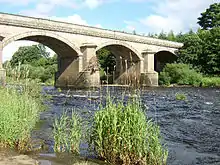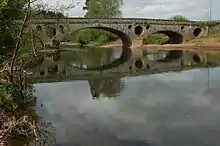Flood arch
A flood arch is a small supplemental arch bridge provided alongside a main bridge. It provides extra capacity for floodwater.[1]

Bywell Bridge, two of the river spans with a flood arch beyond. The level of flooding can be seen by the driftwood caught above the cutwater
The space beneath a flood arch is normally dry and often carries a towpath or similar. In some cases it borders on the shallow edge of a river, but this does not carry substantial flow in normal conditions. A bridge with multiple arches across a flowing river would instead be termed a viaduct.
For some bridges, flood arches were added after the first bridge had been constructed, often after initial flooding.[2]

Pant-y-Goitre Bridge with both pierced spandrels and a flood arch
References
- "Load-carrying capacity of flooded masonry arch bridges, by Author Colin Smith and Matthew Gilbert of The University of Sheffield on Researchgate".
- Crow, Alan (1995). "Bigsweir Bridge". Bridges on the River Wye. Lapridge Publications. pp. 144–145. ISBN 0-9518589-9-8.
This article is issued from Wikipedia. The text is licensed under Creative Commons - Attribution - Sharealike. Additional terms may apply for the media files.
